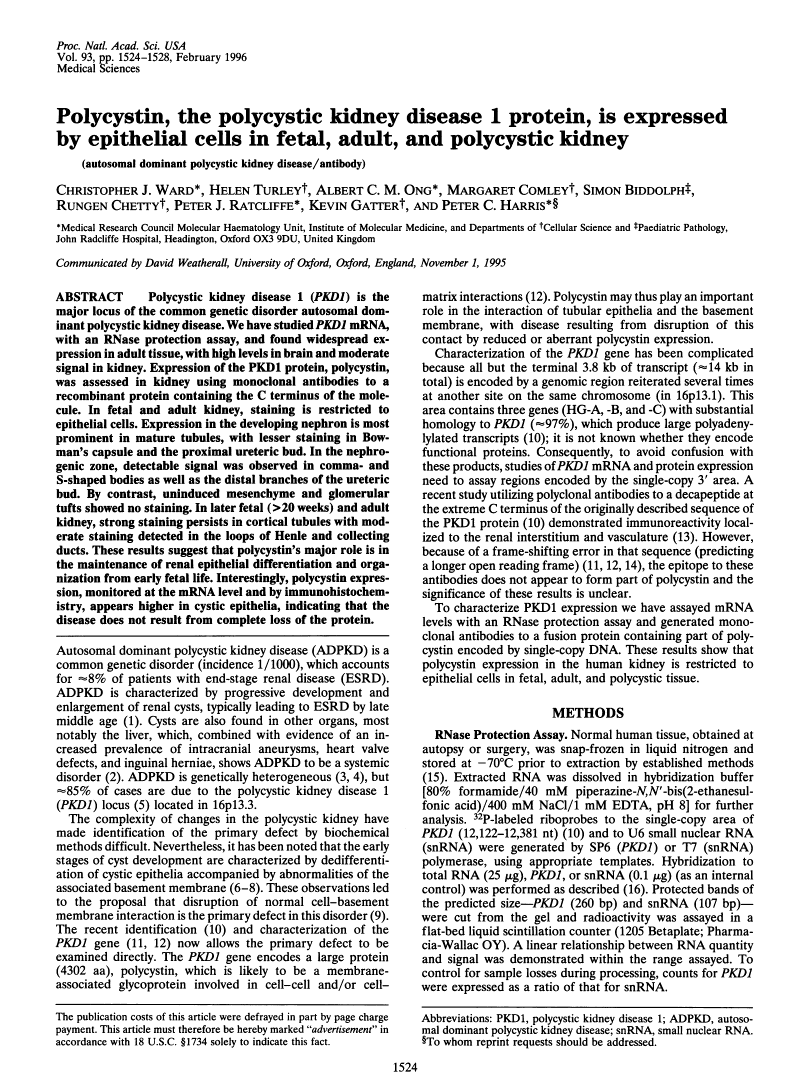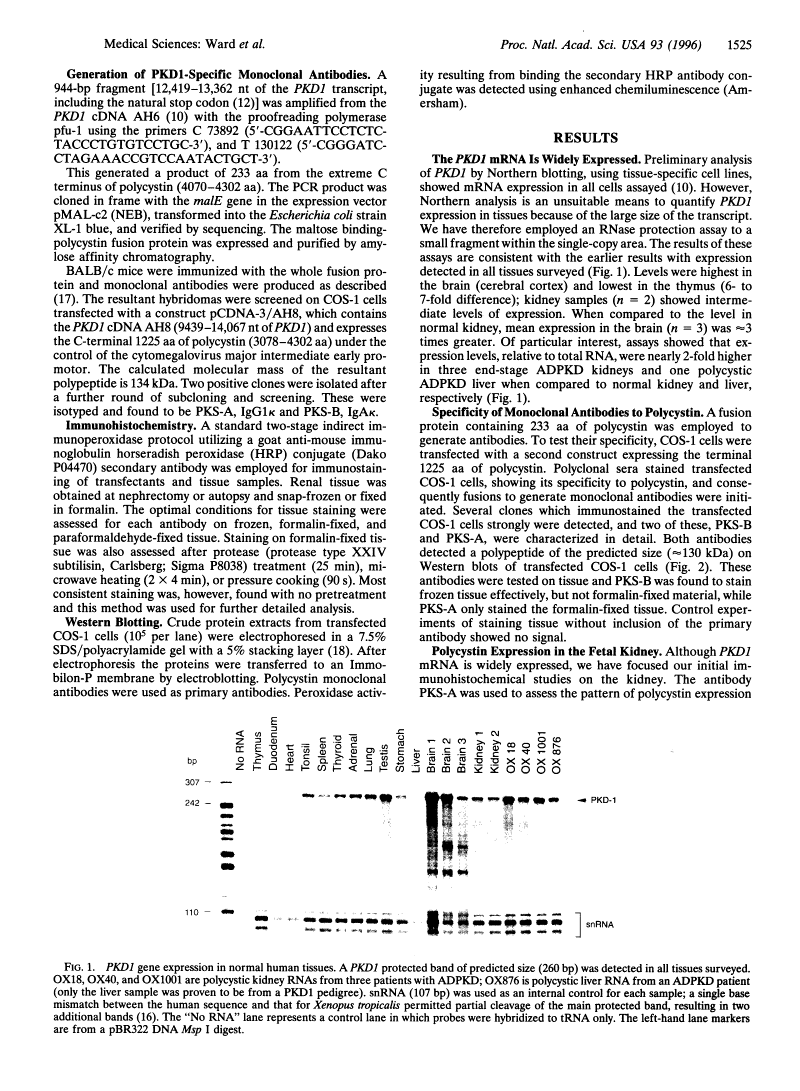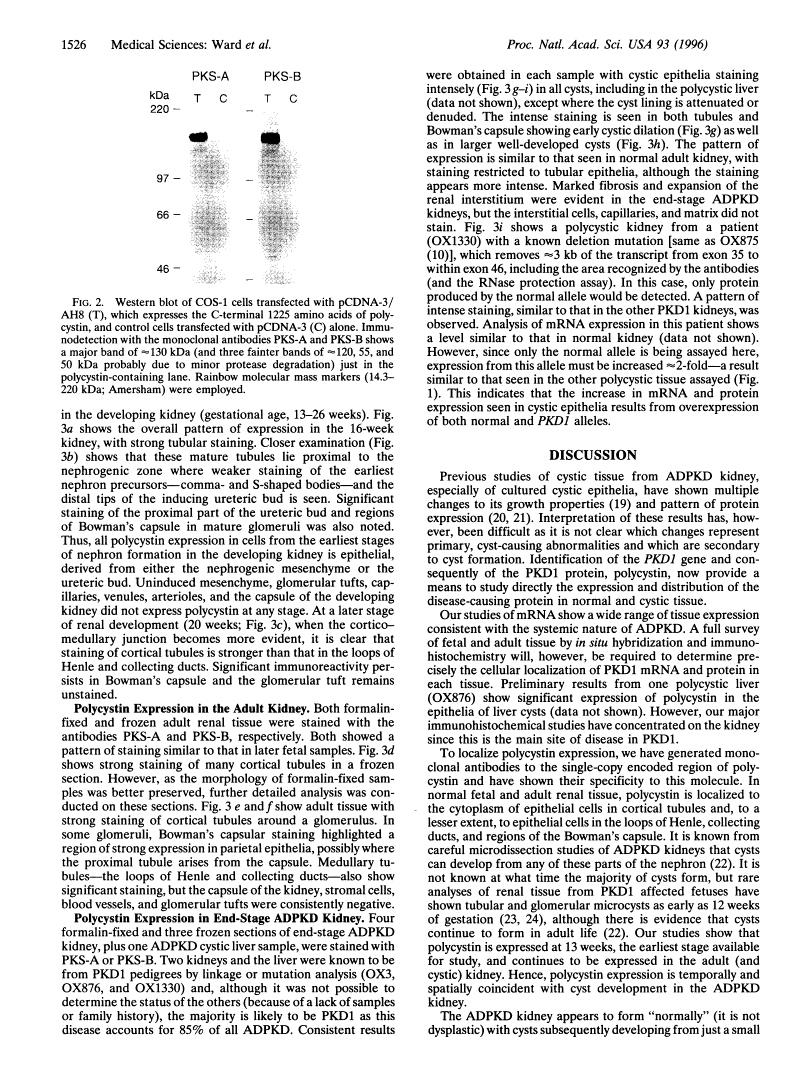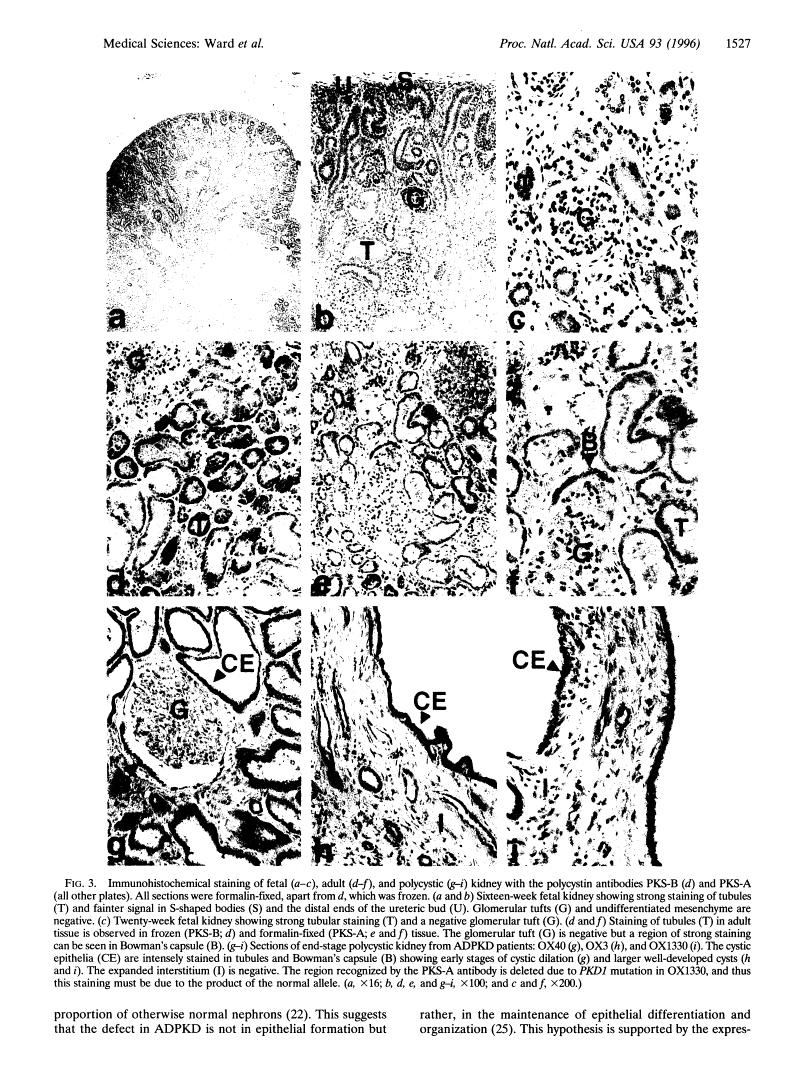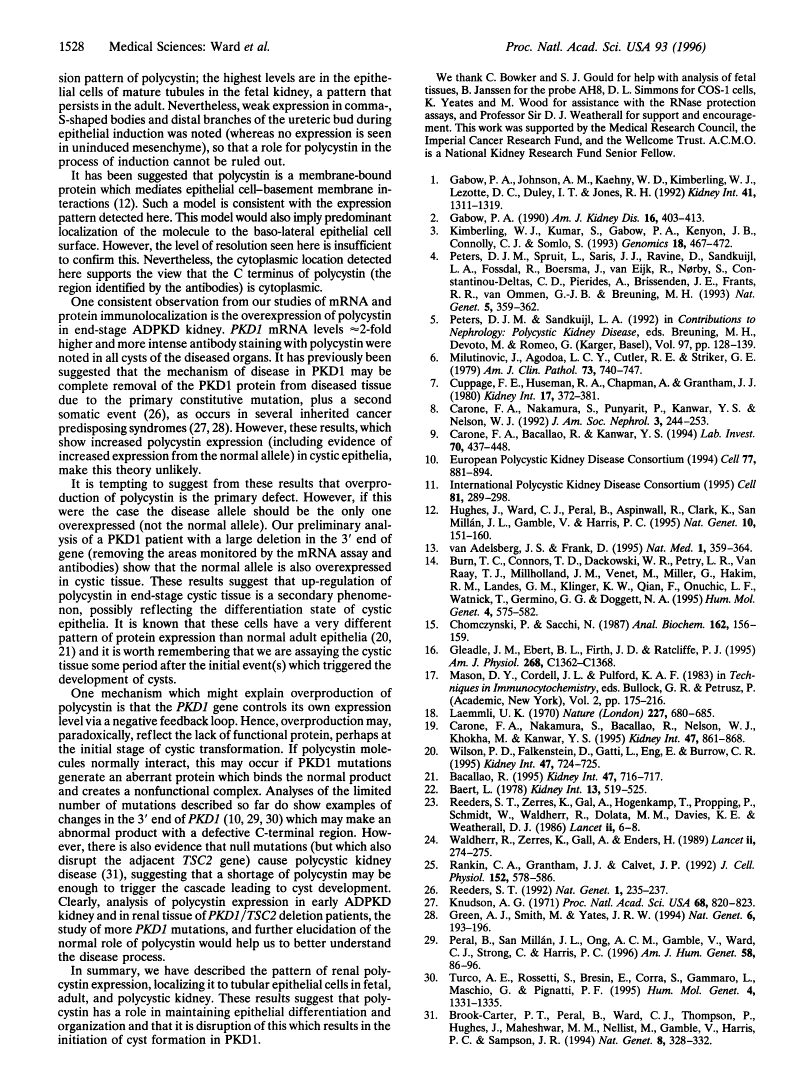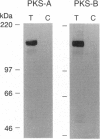Abstract
Free full text

Polycystin, the polycystic kidney disease 1 protein, is expressed by epithelial cells in fetal, adult, and polycystic kidney.
Abstract
Polycystic kidney disease 1 (PKD1) is the major locus of the common genetic disorder autosomal dominant polycystic kidney disease. We have studied PKD1 mRNA, with an RNase protection assay, and found widespread expression in adult tissue, with high levels in brain and moderate signal in kidney. Expression of the PKD1 protein, polycystin, was assessed in kidney using monoclonal antibodies to a recombinant protein containing the C terminus of the molecule. In fetal and adult kidney, staining is restricted to epithelial cells. Expression in the developing nephron is most prominent in mature tubules, with lesser staining in Bowman's capsule and the proximal ureteric bud. In the nephrogenic zone, detectable signal was observed in comma- and S-shaped bodies as well as the distal branches of the ureteric bud. By contrast, uninduced mesenchyme and glomerular tufts showed no staining. In later fetal (>20 weeks) and adult kidney, strong staining persists in cortical tubules with moderate staining detected in the loops of Henle and collecting ducts. These results suggest that polycystin's major role is in the maintenance of renal epithelial differentiation and organization from early fetal life. Interestingly, polycystin expression, monitored at the mRNA level and by immunohistochemistry, appears higher in cystic epithelia, indicating that the disease does not result from complete loss of the protein.
Full text
Full text is available as a scanned copy of the original print version. Get a printable copy (PDF file) of the complete article (2.3M), or click on a page image below to browse page by page. Links to PubMed are also available for Selected References.
Images in this article
Selected References
These references are in PubMed. This may not be the complete list of references from this article.
- Gabow PA, Johnson AM, Kaehny WD, Kimberling WJ, Lezotte DC, Duley IT, Jones RH. Factors affecting the progression of renal disease in autosomal-dominant polycystic kidney disease. Kidney Int. 1992 May;41(5):1311–1319. [Abstract] [Google Scholar]
- Gabow PA. Autosomal dominant polycystic kidney disease--more than a renal disease. Am J Kidney Dis. 1990 Nov;16(5):403–413. [Abstract] [Google Scholar]
- Kimberling WJ, Kumar S, Gabow PA, Kenyon JB, Connolly CJ, Somlo S. Autosomal dominant polycystic kidney disease: localization of the second gene to chromosome 4q13-q23. Genomics. 1993 Dec;18(3):467–472. [Abstract] [Google Scholar]
- Peters DJ, Spruit L, Saris JJ, Ravine D, Sandkuijl LA, Fossdal R, Boersma J, van Eijk R, Nørby S, Constantinou-Deltas CD, et al. Chromosome 4 localization of a second gene for autosomal dominant polycystic kidney disease. Nat Genet. 1993 Dec;5(4):359–362. [Abstract] [Google Scholar]
- Peters DJ, Sandkuijl LA. Genetic heterogeneity of polycystic kidney disease in Europe. Contrib Nephrol. 1992;97:128–139. [Abstract] [Google Scholar]
- Milutinovic J, Agodoa LC, Cutler RE, Striker GE. Autosomal dominant polycystic kidney disease. Early diagnosis and consideration of pathogenesis. Am J Clin Pathol. 1980 Jun;73(6):740–747. [Abstract] [Google Scholar]
- Cuppage FE, Huseman RA, Chapman A, Grantham JJ. Ultrastructure and function of cysts from human adult polycystic kidneys. Kidney Int. 1980 Mar;17(3):372–381. [Abstract] [Google Scholar]
- Carone FA, Nakamura S, Punyarit P, Kanwar YS, Nelson WJ. Sequential tubular cell and basement membrane changes in polycystic kidney disease. J Am Soc Nephrol. 1992 Aug;3(2):244–253. [Abstract] [Google Scholar]
- Carone FA, Bacallao R, Kanwar YS. Biology of polycystic kidney disease. Lab Invest. 1994 Apr;70(4):437–448. [Abstract] [Google Scholar]
- Hughes J, Ward CJ, Peral B, Aspinwall R, Clark K, San Millán JL, Gamble V, Harris PC. The polycystic kidney disease 1 (PKD1) gene encodes a novel protein with multiple cell recognition domains. Nat Genet. 1995 Jun;10(2):151–160. [Abstract] [Google Scholar]
- Van Adelsberg JS, Frank D. The PKD1 gene produces a developmentally regulated protein in mesenchyme and vasculature. Nat Med. 1995 Apr;1(4):359–364. [Abstract] [Google Scholar]
- Burn TC, Connors TD, Dackowski WR, Petry LR, Van Raay TJ, Millholland JM, Venet M, Miller G, Hakim RM, Landes GM, et al. Analysis of the genomic sequence for the autosomal dominant polycystic kidney disease (PKD1) gene predicts the presence of a leucine-rich repeat. The American PKD1 Consortium (APKD1 Consortium). Hum Mol Genet. 1995 Apr;4(4):575–582. [Abstract] [Google Scholar]
- Chomczynski P, Sacchi N. Single-step method of RNA isolation by acid guanidinium thiocyanate-phenol-chloroform extraction. Anal Biochem. 1987 Apr;162(1):156–159. [Abstract] [Google Scholar]
- Gleadle JM, Ebert BL, Firth JD, Ratcliffe PJ. Regulation of angiogenic growth factor expression by hypoxia, transition metals, and chelating agents. Am J Physiol. 1995 Jun;268(6 Pt 1):C1362–C1368. [Abstract] [Google Scholar]
- Laemmli UK. Cleavage of structural proteins during the assembly of the head of bacteriophage T4. Nature. 1970 Aug 15;227(5259):680–685. [Abstract] [Google Scholar]
- Carone FA, Nakamura S, Bacallao R, Nelson WJ, Khokha M, Kanwar YS. Impaired tubulogenesis of cyst-derived cells from autosomal dominant polycystic kidneys. Kidney Int. 1995 Mar;47(3):861–868. [Abstract] [Google Scholar]
- Baert L. Hereditary polycystic kidney disease (adult form): a microdissection study of two cases at an early stage of the disease. Kidney Int. 1978 Jun;13(6):519–525. [Abstract] [Google Scholar]
- Reeders ST, Zerres K, Gal A, Hogenkamp T, Propping P, Schmidt W, Waldherr R, Dolata MM, Davies KE, Weatherall DJ. Prenatal diagnosis of autosomal dominant polycystic kidney disease with a DNA probe. Lancet. 1986 Jul 5;2(8497):6–8. [Abstract] [Google Scholar]
- Waldherr R, Zerres K, Gall A, Enders H. Polycystic kidney disease in the fetus. Lancet. 1989 Jul 29;2(8657):274–275. [Abstract] [Google Scholar]
- Rankin CA, Grantham JJ, Calvet JP. C-fos expression is hypersensitive to serum-stimulation in cultured cystic kidney cells from the C57BL/6J-cpk mouse. J Cell Physiol. 1992 Sep;152(3):578–586. [Abstract] [Google Scholar]
- Reeders ST. Multilocus polycystic disease. Nat Genet. 1992 Jul;1(4):235–237. [Abstract] [Google Scholar]
- Knudson AG., Jr Mutation and cancer: statistical study of retinoblastoma. Proc Natl Acad Sci U S A. 1971 Apr;68(4):820–823. [Europe PMC free article] [Abstract] [Google Scholar]
- Green AJ, Smith M, Yates JR. Loss of heterozygosity on chromosome 16p13.3 in hamartomas from tuberous sclerosis patients. Nat Genet. 1994 Feb;6(2):193–196. [Abstract] [Google Scholar]
- Peral B, San Millán JL, Ong AC, Gamble V, Ward CJ, Strong C, Harris PC. Screening the 3' region of the polycystic kidney disease 1 (PKD1) gene reveals six novel mutations. Am J Hum Genet. 1996 Jan;58(1):86–96. [Europe PMC free article] [Abstract] [Google Scholar]
- Turco AE, Rossetti S, Bresin E, Corra S, Gammaro L, Maschio G, Pignatti PF. A novel nonsense mutation in the PKD1 gene (C3817T) is associated with autosomal dominant polycystic kidney disease (ADPKD) in a large three-generation Italian family. Hum Mol Genet. 1995 Aug;4(8):1331–1335. [Abstract] [Google Scholar]
- Brook-Carter PT, Peral B, Ward CJ, Thompson P, Hughes J, Maheshwar MM, Nellist M, Gamble V, Harris PC, Sampson JR. Deletion of the TSC2 and PKD1 genes associated with severe infantile polycystic kidney disease--a contiguous gene syndrome. Nat Genet. 1994 Dec;8(4):328–332. [Abstract] [Google Scholar]
Associated Data
Articles from Proceedings of the National Academy of Sciences of the United States of America are provided here courtesy of National Academy of Sciences
Full text links
Read article at publisher's site: https://doi.org/10.1073/pnas.93.4.1524
Read article for free, from open access legal sources, via Unpaywall:
https://europepmc.org/articles/pmc39973?pdf=render
Citations & impact
Impact metrics
Citations of article over time
Alternative metrics
Smart citations by scite.ai
Explore citation contexts and check if this article has been
supported or disputed.
https://scite.ai/reports/10.1073/pnas.93.4.1524
Article citations
Cilia-enriched oxysterol 7β,27-DHC is required for polycystin ion channel activation.
Nat Commun, 15(1):6468, 31 Jul 2024
Cited by: 0 articles | PMID: 39085216 | PMCID: PMC11291729
Cleavage fragments of the C-terminal tail of polycystin-1 are regulated by oxidative stress and induce mitochondrial dysfunction.
J Biol Chem, 299(9):105158, 12 Aug 2023
Cited by: 4 articles | PMID: 37579949 | PMCID: PMC10502374
Polycystic kidneys: interaction of notch and renin.
Clin Sci (Lond), 137(15):1145-1150, 01 Aug 2023
Cited by: 0 articles | PMID: 37553961 | PMCID: PMC11132639
Mechanisms of Cyst Development in Polycystic Kidney Disease.
Adv Kidney Dis Health, 30(3):209-219, 01 May 2023
Cited by: 4 articles | PMID: 37088523 | PMCID: PMC10289784
Review Free full text in Europe PMC
Modeling Pkd1 gene-targeted strategies for correction of polycystic kidney disease.
Mol Ther Methods Clin Dev, 29:366-380, 03 Apr 2023
Cited by: 1 article | PMID: 37214311 | PMCID: PMC10199405
Go to all (133) article citations
Data
Similar Articles
To arrive at the top five similar articles we use a word-weighted algorithm to compare words from the Title and Abstract of each citation.
Polycystin expression is temporally and spatially regulated during renal development.
Am J Physiol, 272(5 pt 2):F602-9, 01 May 1997
Cited by: 31 articles | PMID: 9176370
Characterization and cell distribution of polycystin, the product of autosomal dominant polycystic kidney disease gene 1.
Mol Med, 2(6):702-711, 01 Nov 1996
Cited by: 39 articles | PMID: 8972485 | PMCID: PMC2230129
Adult, fetal, and polycystic kidney expression of polycystin, the polycystic kidney disease-1 gene product.
Lab Invest, 75(2):221-230, 01 Aug 1996
Cited by: 25 articles | PMID: 8765322
Epithelial cell polarity and disease.
Am J Physiol, 272(4 pt 2):F434-42, 01 Apr 1997
Cited by: 54 articles | PMID: 9140043
Review
Funding
Funders who supported this work.
